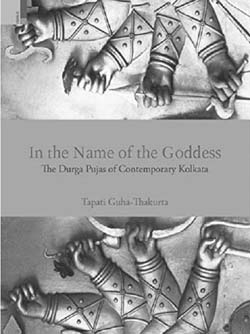To a Kolkata-Bengali to the core like me, who unfortunately has lived out of the city for almost a quarter of a century now and in this period has been to the city only once during the Pujas, that too more than a decade back, and yet who is aware of the fact that it is exactly during this period that Durga Puja in Kolkata has completely metamorphosed, and is vaguely aware of what he has missed out on, this beautifully produced book came quite literally as godsend. Beautiful the book certainly is—shaped, sized, priced, and in looks as it is like a coffee table book—with glossy pages, a wonderfully designed dust jacket, and almost five hundred full-colour photographs, and yet it is not your usual coffee table book: it is a massively researched academic work—replete as it is with all the formal trappings of such a work, with elaborate endnotes, glossary, bibliography and index. And, it is this curious admixture of genres and formats that this book has to be judged for, and one has to question, in the final analysis, whether this attempt at fusion of styles works or not. Individually one can hardly have any doubts about either the compelling beauty of the lovely Durga Puja vignettes peering out of every page, or the arduous research of a scholar as formidable as Tapati Guha-Thakurta, but the test has to be whether the coexistence of the two succeeds. It seems the author herself is also aware of this tension; she says in the Preface, ‘This was meant to have been a short, non-academic book that I thought I could write after two or three seasons of research. In 2002–03, I could never have anticipated that it would end up in its present form and take the many years it has to be completed. […] Unlike any other book I have written, this one has pushed me into taking many disciplinary liberties and leaps. […] I found myself grappling with the challenge of writing a new kind of academic-cum-pictorial book, where I could dispense with concepts and theories in my narrative and use my visuals not merely as illustrations but as the ground on which the work stands’ (p. ix). But before I could share my own, tendentious, personal opinion on whether the book passes this crucial test, let me share with the current reader what the book’s primary concerns are, and how it structures and presents the same.
The object of study for this book is the spectacular extravaganza of the Kolkata Durga Puja that takes over the city every autumn in an ephemeral riot of colours and sounds, in a most amazing melee of the sacred and the profane, of the artistic and the commercial, of devotion and consumption. Specifically, the book takes up for study how from the turn of the twenty-first century, the festival has taken on a particularly discernible unique aesthetics, and through elaborate field-research conducted between 2002 and 2012 of several pujas in the city, it traces the production processes and spectatorial practices of this new visual aesthetic of the emergent new genres of public art. It does so through a Preface, an Introduction and eight chapters, which cumulatively trace the new protocols that the Kolkata Durga Puja seems to have taken up in the last fifteen years or so. The Introduction begins with recounting the myths and legends associated with Durga Puja, and also the history of the beginnings of the annual Durga Puja in Kolkata, but declaredly chooses to refrain elaborating on the same, and instead focuses, rightly, on what it calls the ‘non-religious’ elements in the puja festivities, thus building up the case for studying the aesthetic, social and commercial aspects that Kolkata Durga Puja gets primarily identified with in the decade that this book takes up for research.

